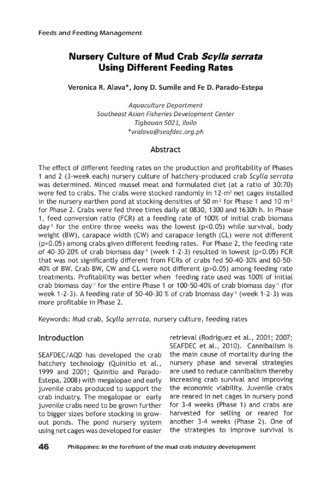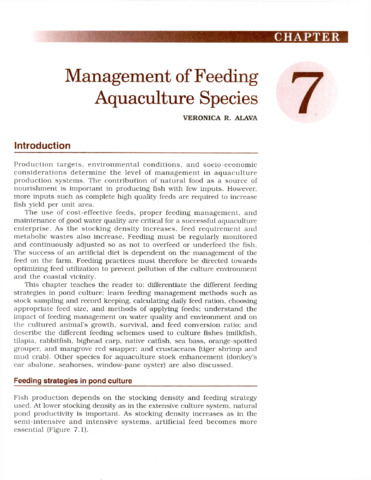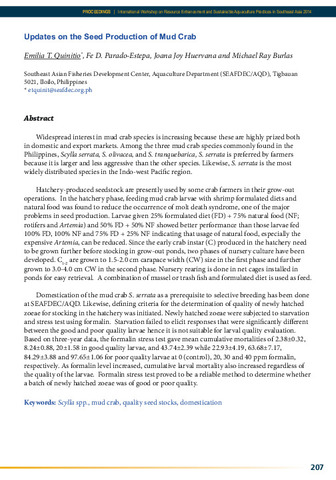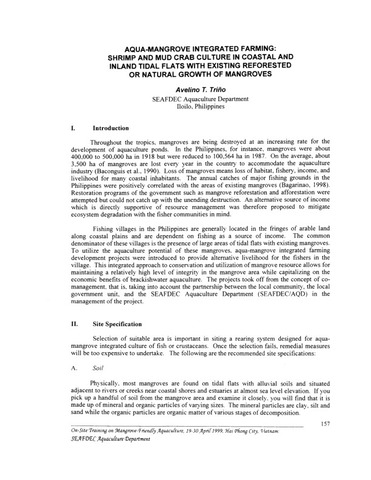Nursery culture of mud crab Scylla serrata using different feeding rates
Share
Abstract
The effect of different feeding rates on the production and profitability of Phases 1 and 2 (3-week each) nursery culture of hatchery-produced crab Scylla serrata was determined. Minced mussel meat and formulated diet (at a ratio of 30:70) were fed to crabs. The crabs were stocked randomly in 12-m2 net cages installed in the nursery earthen pond at stocking densities of 50 m-2 for Phase 1 and 10 m-2 for Phase 2. Crabs were fed three times daily at 0830, 1300 and 1630h h. In Phase 1, feed conversion ratio (FCR) at a feeding rate of 100% of initial crab biomass day-1 for the entire three weeks was the lowest (p<0.05) while survival, body weight (BW), carapace width (CW) and carapace length (CL) were not different (p>0.05) among crabs given different feeding rates. For Phase 2, the feeding rate of 40-30-20% of crab biomass day-1 (week 1-2-3) resulted in lowest (p<0.05) FCR that was not significantly different from FCRs of crabs fed 50-40-30% and 60-50-40% of BW. Crab BW, CW and CL were not different (p>0.05) among feeding rate treatments. Profitability was better when feeding rate used was 100% of initial crab biomass day-1 for the entire Phase 1 or 100-50-40% of crab biomass day-1 (for week 1-2-3). A feeding rate of 50-40-30 % of crab biomass day-1 (week 1-2-3) was more profitable in Phase 2.
Suggested Citation
Alava, V. R., Sumile, J. D., & Parado-Estepa, F. D. (2017). Nursery culture of mud crab Scylla serrata using different feeding rates. In E. T. Quinitio, F. D. Parado-Estepa, & R. M. Coloso (Eds.), Philippines : In the forefront of the mud crab industry development : proceedings of the 1st National Mud Crab Congress, 16-18 November 2015, Iloilo City, Philippines (pp. 46-51). Tigbauan, Iloilo, Philippines: Aquaculture Department, Southeast Asian Fisheries Development Center.
Subject
Taxonomic term
Related items
Showing items related by title, author, creator and subject.
-
Management of feeding aquaculture species
Alava, Veronica R. (Aquaculture Department, Southeast Asian Fisheries Development Center, 2002)This chapter teaches the reader to: differentiate the different feeding strategies in pond culture; learn feeding management methods such as stock sampling and record keeping, calculating daily feed ration, choosing ... -
Updates on the seed production of mud crab
Quinitio, Emilia T.; Parado-Estepa, Fe D.; Huervana, Joana Joy; Burlas, Michael Ray (Aquaculture Department, Southeast Asian Fisheries Development Center, 2015)Widespread interest in mud crab species is increasing because these are highly prized both in domestic and export markets. Among the three mud crab species commonly found in the Philippines, Scylla serrata, S. olivacea, ... -
Aqua-mangrove integrated farming: Shrimp and mud crab culture in coastal and inland tidal flats with existing reforested or natural growth of mangroves
Triño, Avelino T. (Aquaculture Department, Southeast Asian Fisheries Development Center, 2000)Throughout the tropics, mangroves are being destroyed at an increasing rate for the development of aquaculture ponds. In the Philippines, for instance, mangroves were about 400,000 to 500,000 ha in 1918 but were reduced ...






